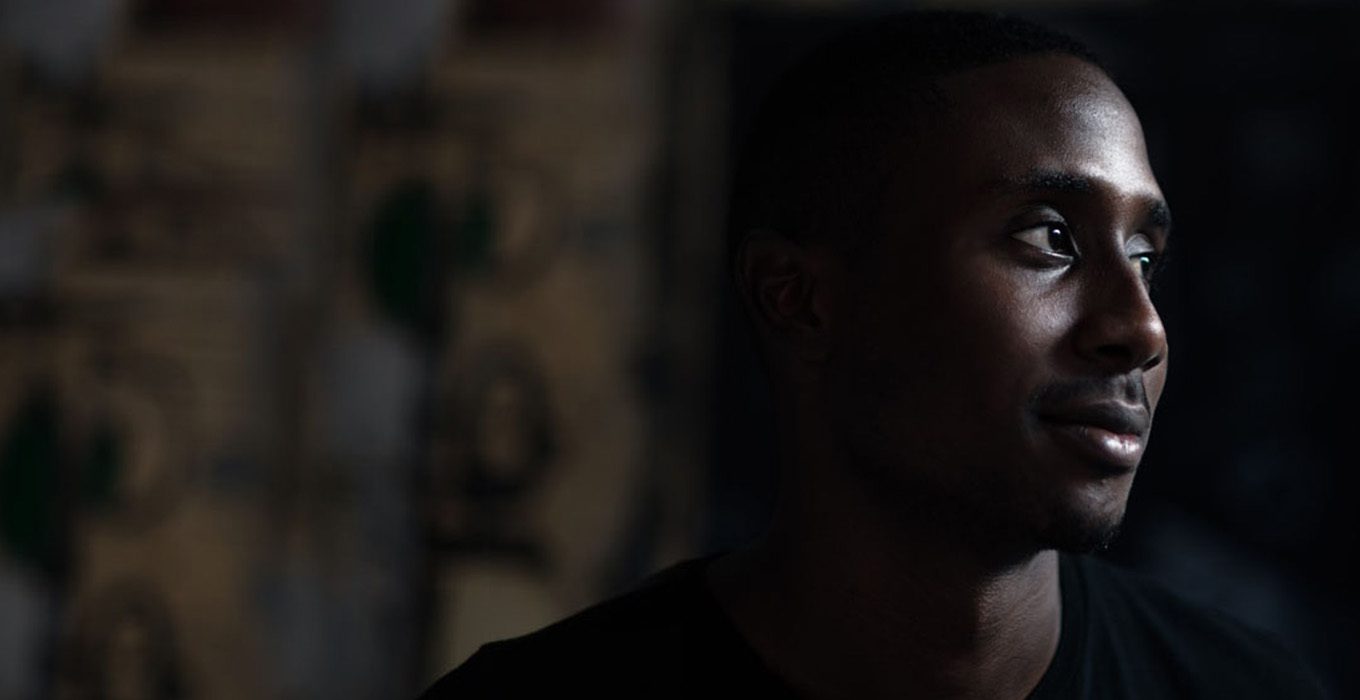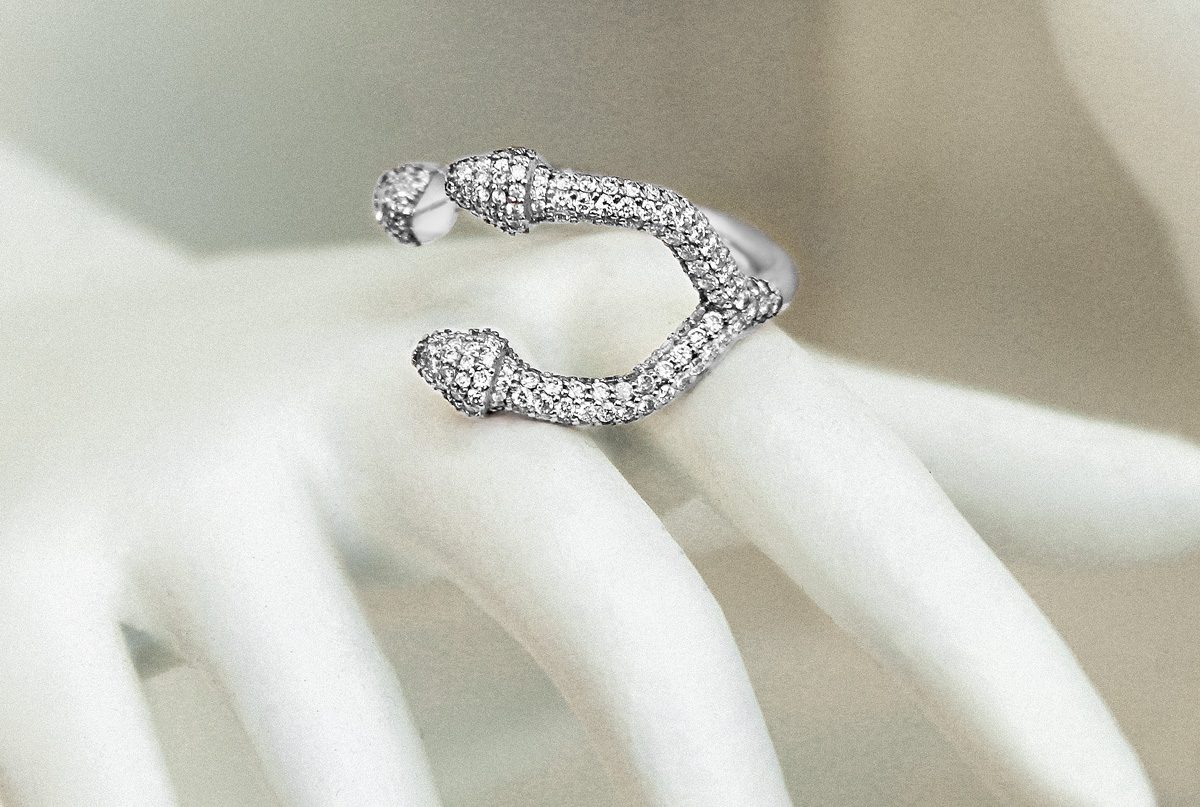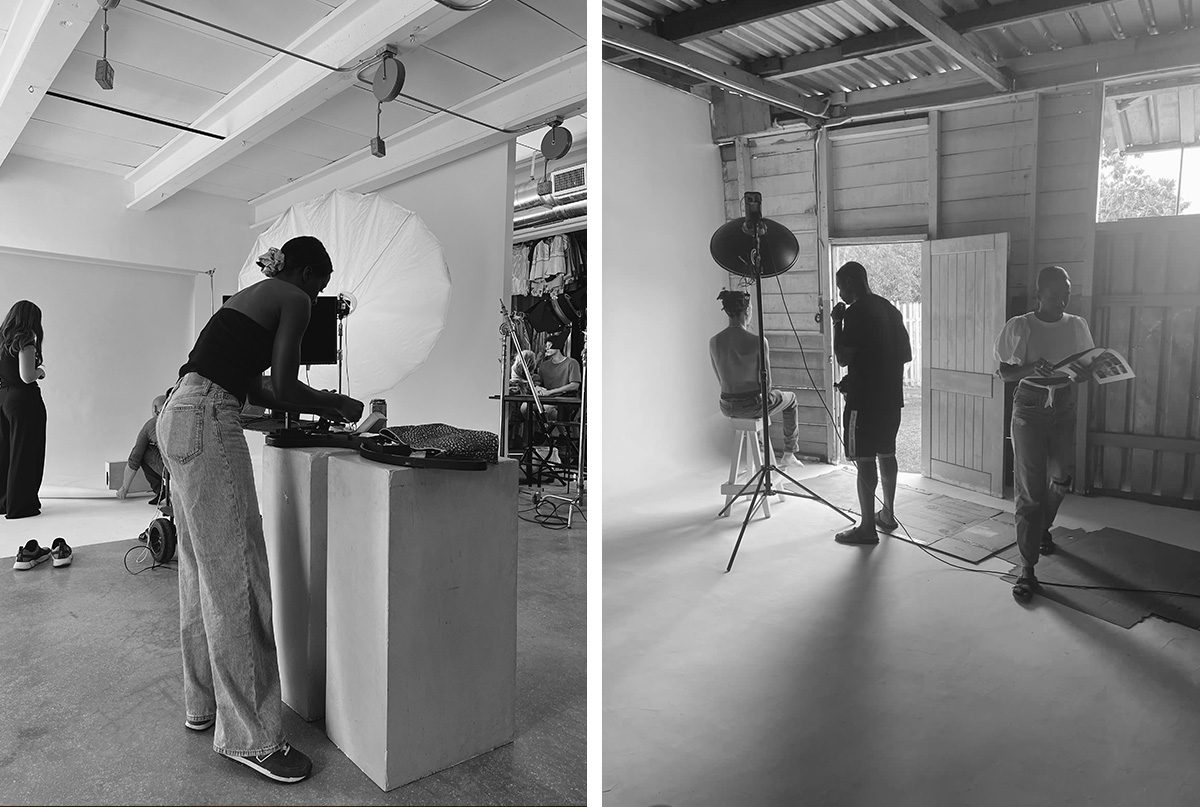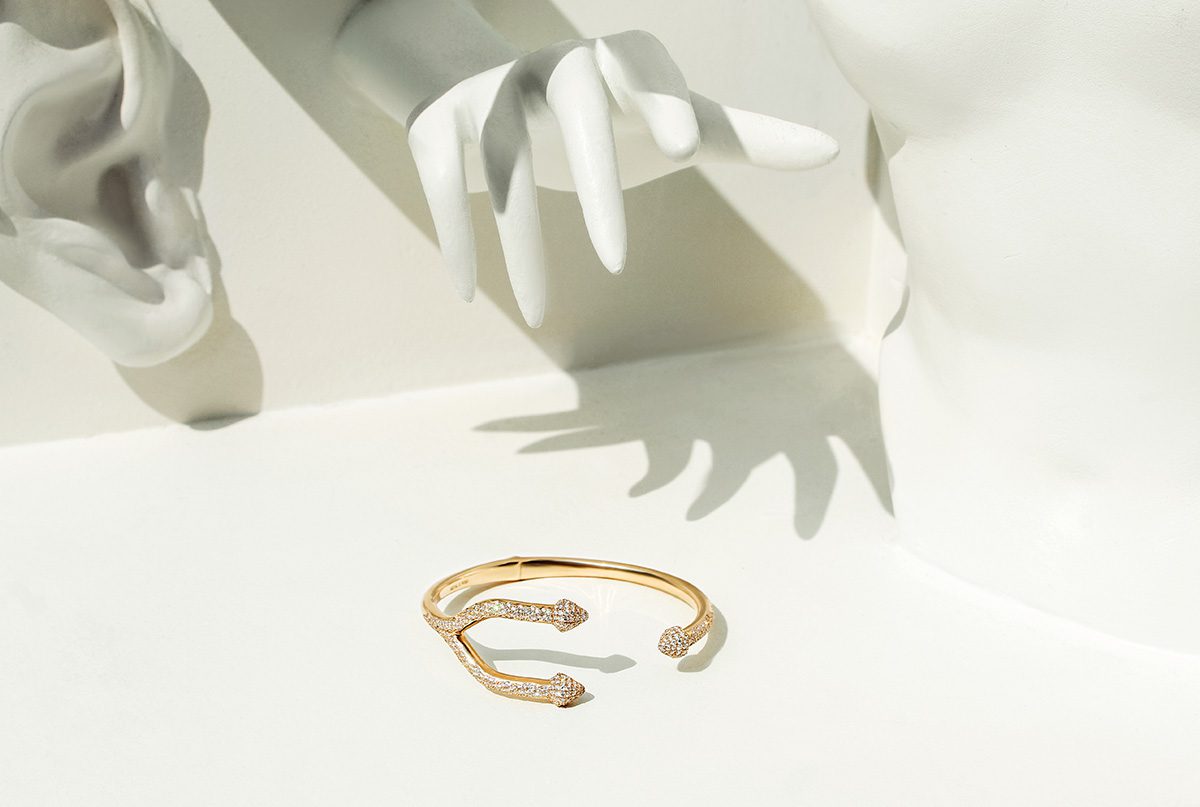

OCTOBER 15th, 2023
“I was always allergic to anything less than 14k gold…” said a tired but spirited Symoné Currie.
Symoné sat below a bold and vibrant painting, educating me on this common jewellery woe we both share. “Fourteen karats is 58.8% pure gold. It’s not about being bougie. Anything lower and you’re mixing alloys like brass and copper – that’s what your body’s reacting to.”
Symoné Currie, is the founder and creative genius at the helm of ‘Metal x Wire’ -a brand that embraces fluidity and individual expression with a penchant for melding the delicate with the daring in a way that challenges tradition. In just two years, the architectural designer-turned-jewellery-designer managed to achieve an exceptional feat in the industry, transitioning from creating demi-fine jewellery (a level between costume jewellery and fine jewellery) to designing fine jewellery exclusively and working with the most premium of stones- diamonds. Of this feat Symoné says, “It’s what I call my divine path. It’s not a coincidence. There are too many things that happened too ‘coincidentally’ for it to be a ‘coincidence’. It was aligned.”
We scheduled our conversation strategically so Symoné could catch up on well-deserved sleep after previewing her unreleased diamond collection in Las Vegas. The launch of this much-anticipated collection will be the grand finale of her year-long journey as part of the Emerging Designers Diamond Initiative. The programme, led by the Natural Diamonds Council and well-established designer, Lorraine Schwartz, empowers Black, Indigenous, and People of Color (BIPOC) jewellery designers with unrivalled support to add diamonds to their portfolio. Each year a hand-selected cohort gains access to resources, including industry education, retail opportunities, expert mentorship, and a combined one million dollars in diamond credit. 2023 is Symoné’s year.
Between golden nuggets of wisdom, an exchange of personal stories, and a legion of laughs, our conversation felt like catching up with a friend:
First off I want to be sure I’m saying your name correctly…
Symoné: My first name is actually Courtnae-Symoné. It’s too long. Twenty-six letters in one first name? It’s ridiculous. It’s funny when people think the ‘e’ has a long ‘a’ sound but, listen, my mum just really liked that Raven Symoné had the accent over the ‘e’. Courtnae is my dad’s name. He wanted a son and I imagine he was like “Oh, it’s a girl? Slap on a female name at the end.”
How was your trip?
Symoné: It was a lot of work but great. What happened in Vegas was just a preview for the fall. They (the organisers of the Emerging Designers Diamond Initiative) do a lot to push us, they’re like a catalyst. They put you in the room with the right people – with mentors. My mentor is amazing and super helpful but they also have a nine-to-five so you have to work equally as hard beside them.
As a self-taught designer, how has having a mentor impacted your trajectory?
Symoné: A lot of people have said to me, “Do you know how many jewellery designers there are?” It takes a lot to stand out. Having a mentor is key in strengthening how you present. Honing your positioning and how you think about your brand holistically. You could have the greatest designs ever but without this knowledge, it goes nowhere. And I’ve experienced that actually with ‘The Legacy Bangle’, People tried to minimise the price but the price is what it’s worth. I wasn’t positioning to the right audience. You go to another audience and people are looking at your over-five-digit item and say, “That’s reasonably priced!”. Having a mentor guide me through this really validated a lot of what I thought. I’ve always thought my designs are dope.
You started Metal x Wire by doing demi-fine jewellery. Did you transition to fine jewellery because of the Emerging Designers Diamond Initiative or was it always in the cards?
Symoné: I’ve always wanted to do fine jewellery but it comes with a certain price point. My mum was also against me doing demi-fine but you get so in your head about what will sell. I wasn’t being true to myself I was doing what was easy, affordable and what made sense in Jamaica. It’s hard to pivot into it without a backing. Production is expensive, marketing is expensive, whatever you’re doing… it’s expensive. Once I knew I got into this programme I decided to pivot. It’s opened up so many doors for me already, I trust I’ll be okay.
How old is Metal x Wire?
Symoné: Officially, we’re 2 years old.
Why does it feel longer?
Symoné: You’ve seen me posting when I was experimenting. I kinda did that publicly, that’s why it seems longer. I was experimenting with Metal x Wire during the pandemic. I had a little pop-up in Jamaica. I was doing dainty things that’s not my style and I hated it. It’s been an iterative process, like, “This is it! Oh no, guys, I’ve changed my mind.”
The upside of public experimentation is your community saw you evolve. It’s nice to notice the elements that have stuck around and just as amazing to see the brand grow.
Symoné: I’m ready to grow more! My company is currently comprised of me and my many personalities. Based on where I want to go it’s time to bring people on. It takes a big push, but nothing before its time.
So far, I’ve lucked out in a lot of ways. I have super-talented friends. I have friends who are really good photographers who’ll give advice or do minor edits. I also have friends in finance who’ll help assess net profit margins for each item and then I have the skill set to analyse it. I could never say I did this by myself.
I’m also really proud to say I’ve used a lot of Jamaican talent on the backend for creative work. It’s important to me. We all know what it’s like to only be appreciated after getting on an international platform. It’s not to say that everybody in the Caribbean doesn’t appreciate creative work. I’m talking about some of the large corporations that will pay a foreign entity USD and they will downgrade the locals producing the same quality of work. Crazy right? We’re playing on a digital global landscape our work should be equally valued. When you go abroad they really value your eye. Our perspectives are hard to cultivate.
What drew you to jewellery design?
Symoné: My mum bought me, you know the traditional Caribbean bangle? That’s where the Legacy line comes from. I had two. I’m a quasi-dainty girl you have to remind me to be delicate. I remember one of them snapped and I was like “If I wear that again it has to be sturdier. Let’s find something that’s more like me.”
There’s an Instagram post on my personal account from October 29th that reads “Keeping myself accountable by immortalising my thoughts here.” That’s when I realised I kept on thinking about jewellery and designing. Another read, “Currently on this wave where I’m trying to execute every creative idea that comes to mind, especially the ones that linger in my thoughts for more than 3 days. Let’s see what magic unfolds.” That’s the inception.
2020 came, Pandemic, and then a year later I decided to try again. The point is, to hold yourself accountable. You said something. If it’s bothering you, you’re probably meant to pursue it. It’s probably aligned with whatever path you’re meant to take. None of this is a coincidence. I have no connections in jewellery, minor connections in fashion. Every time I’m ‘accidentally’ bumping into people. That’s not a coincidence. Everyone has this thing in them that’s nagging them. Just start. It might be slow growth but just start.
Has art always been present in your life?
Symoné: It wasn’t encouraged as a profession but my aunt is an architect and she paints, my mum draws really well, she taught me how to draw, and my grandma created clothes from scratch, baked from scratch. I grew up in a household where imagination was encouraged.
My grandpa is very stern but if you had the audacity to ask for sh*t he would follow through. I remember one time my cousin and I were at grandpas house and we saw a treehouse on tv and wanted to build it. We asked him and he laughed but, I kid you not, in three days we had a mini trailer in the yard. French windows, French doors, electricity. There was a lot of creativity that was encouraged but not as a profession cause “dat doh pay.”
So I take it studying Architectural Design wasn’t by choice?
Symoné: I wanted to go to a school of art and design and become a film director. I wanted to direct music videos. I was obsessed with MTV in the morning. My mum sat me down and said, “Listen, you’re not living on my pension. Pick something that pays.” She still encouraged me to pursue art on the side, she just wanted me to be financially secure.
Tell me more about your career in Architectural Design.
Symoné: I started school doing civil engineering cause I was really good at math. In the sophomore year, they offered students the opportunity to study architectural engineering. I was in the first class to graduate with that degree from my college. I loved it cause there’s art history and design. I then interned with my dream company and realised there wasn’t much room locally for creativity in that field. The people who got to design weren’t in the local offices, they were abroad, so I went to Duke to do my master’s. I used those skills to segue into project management and worked in Boston for a while. I loved it for ordering artwork and selecting tiles but It was stressful and I had no family there. Also, luxury real estate in Boston as a person of colour… they have a lot of work to do regarding diversity.
When I decided to do jewellery, I found those transferable skills came in handy once again. The details weren’t novel. I definitely got some raised eyebrows when I left my job but I figured it out by the grace of God grace and with amazing friends and a support system and that never allowed me to quit.
Working in fine jewellery as a Black Caribbean woman do you still experience that struggle with diversity?
Symoné: Yeah, but at least it’s more fun. I’m used to working in corporate so it wasn’t jarring and I enjoy it cause I’m repping my designs and I have more control. I set the expectations and if I don’t feel comfortable in a room I can leave. It helps that many councils, like the Natural Diamond Council, are pushing diversity. The higher-ups aren’t disillusioned.
You’ve said before your designs don’t fit gendered stereotypes. Why is this important to you?
Symoné: I grew up as a tomboy with the traditional Caribbean expectations of women. My grandmother wanted to send me to finishing school in Switzerland because I was wearing Timberlands and jeans and white t-shirts trying to look like my grandfather. Of all the grandkids I was the only girl. If they were calling someone to the kitchen you know who they’d be calling, while everybody else is outside having fun. I got around that by doing homework. Schoolwork was the key. That’s why I’m so smart cause I never wanted to do housework. Now I’m a little more girlie. I’m the same girl who’ll go to a fashion show but will call up friends for a hike. My family is quite shocked that it’s come full circle.
I really think people should just be allowed to express themselves. I don’t want to tell anyone what they can or can’t wear cause I hated when people did that to me. Jewellery is a fun medium. It doesn’t have to be ultra-masculine or feminine or dark or light. I think people should just be people.
What other brand values do you hold dear?
Symoné: Sustainability. I’m building from the ground up and it’s hard to do without a large capital backing but it’s one of my longer-term goals.
I also want to give back. Within the next five years, I’d love to create a fund for Caribbean creatives. If it hadn’t been for my privilege I wouldn’t be here. Being in the arts is a privilege. There are so many talented people who just need the support or the right audience. Just because you don’t have the resources or you’re not appreciated in a certain sphere doesn’t mean your work isn’t good. That’s very close to my heart.
Where my stones are sourced is also important. Ethically sourced diamonds are important. Through this programme, I learned about lab-grown diamonds. They are a really big wave right now but they aren’t really sustainable and they lose value rapidly. I have a friend from Botswana who validates stones for me.
Lastly, items are always made to order. It’s a longer wait time but it’s worth it. I’m really big on slow, intentional production.
What do you hope your customers experience when they purchase a piece?
Symoné: I hope it becomes part of their story and inspires them to create their own story. I hope it influences them to appreciate art. I hope they’re proud to wear it and happy with the quality and production. Mostly, I hope it makes them feel special.



Interviewer: Amalda Quong Sing | Portrait Photography by: Ab Mair | Jewelry photography by: Symoné Currie